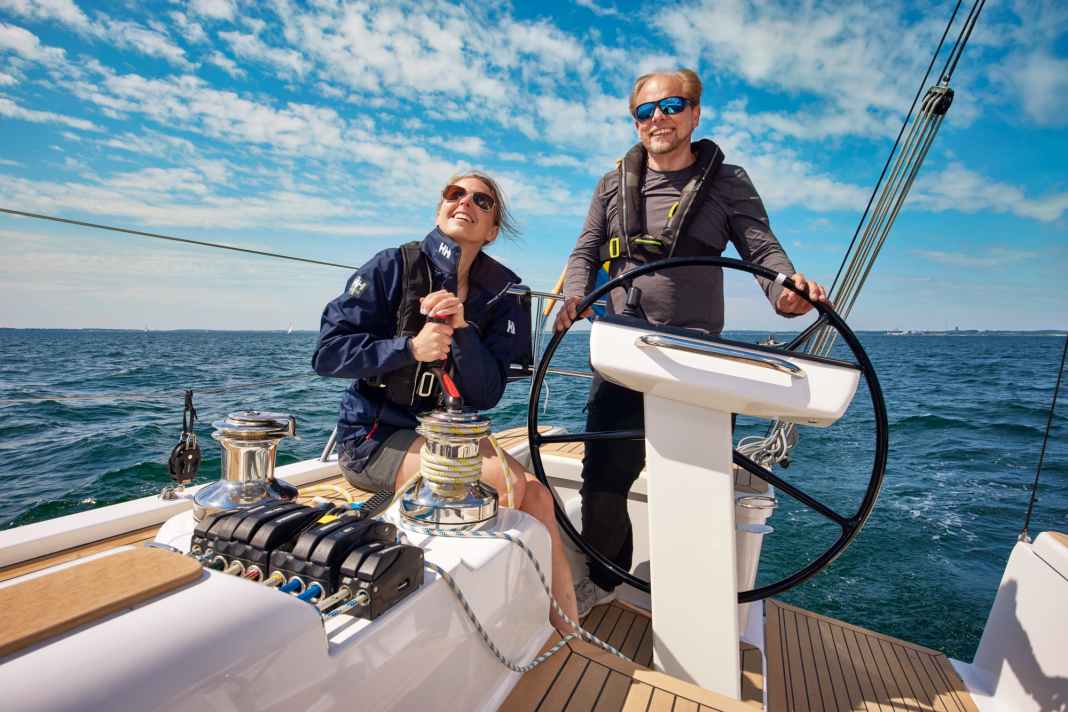



The prospects are good. The will to buy is there, the budget is available and the issue of the harbour site has also been resolved. Now all that remains is to clarify the all-important question: Which is the right boat? Buyers have to ask themselves a thousand questions to evaluate their dream yacht and make their choice from an extremely diverse and almost unmanageable range. It makes no difference whether they buy new or look around the market for used boats.
The restrictions regarding length, width and draught reduce the possible selection to a fraction of the wide-ranging overall offer. In addition, the budget available for the new purchase narrows down the choice. These selections are tangible, data-based and therefore ultimately simple. The more difficult main task for buyers is to determine what type of boat they want, what it should be able to do and for what use it is suitable. Opinions differ on these questions, and wrong decisions often harbour the potential for bitter disappointment.
Also interesting:
However, the variety of boat concepts within a certain length class can be easily sorted. The decisive criteria are based on characteristics such as comfort, volume, sportiness, safety or performance, to name but a few. In addition, there are characteristics for use, whether as a comfortable touring boat, a high-performance regatta yacht, a simple weekender or a robust blue water vessel.
The longer the yacht, the greater the overlap between the different concepts
In addition to shapes, materials and constructions, the design of the decks and the layouts in the cockpit determine the different categories. Basically, the longer the yacht, the greater the overlap between the different concepts. Large ships can have a sporty cockpit layout for active sailing, but at the same time offer a great deal of comfort. For this reason, this analysis is primarily focussed on the more moderate dimensions. For smaller and medium-sized yachts, the boundaries are generally clearer and the compromises are therefore greater.
With a typical cruising yacht of eleven or twelve metres in length, the focus is on the amenities for a relaxed and enjoyable trip, whether with a small crew, several guests or the whole family. One focus is on the length of the thwarts, so that larger groups can still sit together comfortably or enjoy a sunbath stretched out in the bay. On the other hand, the steering columns on real cruisers are often mounted very far aft and offer the helmsman behind them very little space in his working area, especially on smaller yachts with a hull length of ten metres or less.
The typical layout of a modern cruising yacht is usually very simple. This means that the halyards and the most important trim lines run over the coachroof to one or two winches positioned to the side of the companionway. The sheets for the mainsail and headsail are redirected aft, usually to two winches that are screwed far aft on the coaming and can also be operated there by the helmsman. This means that the layouts of cruising yachts are also suitable for sailors who often sail single-handed and are happy with a frugal but all the more enjoyable trip.
The simple basic equipment in the cockpit of cruising yachts is often due to their use in the worldwide charter business
In the meantime, layouts have also become established in which all sheets, halyards and reefing and trim lines are led directly to the steering columns over or inside the coaming all the way aft. This is implemented very consistently by the large series manufacturer Hanseyachts for the entire touring programme and is also increasingly being used on other cruising boats. With this layout, the helmsman can carry out all the procedures for setting and trimming the sails from his position at the wheel. However, because there are a lot of lines at the stern and usually only one winch available, the manoeuvres require an overview, good preparation and more time to complete. And the crew can usually only help to a limited extent, if at all, due to the very cramped position of winches and stoppers directly in front of the steering positions.
The usually very modest basic equipment in the cockpit of cruising yachts is in many cases also due to their use in the global charter business. The charter companies demand the simplest and therefore least cost-intensive concept possible; their customers have no problems with this. As a result, the standard ex-shipyard may lack amenities that would actually be part of a general cruising boat, such as a bathing platform or cockpit table. Unfortunately, these components often have to be ordered as extras at extra cost when purchased by owners.
However, anyone who wants to sail actively on a touring boat, perhaps even with a crew, will find little fulfilment with this type of cockpit design. The sheet winches at the back of the coaming are usually very difficult for the crew to reach from the cockpit, and the handling is strenuous. Many manufacturers of designated cruising yachts therefore offer sporty equipment packages for their boats, for example with additional winches on the coaming, an overlapping genoa with line-adjustable hoisting points instead of the self-tacking jib or a traveller for guiding the mainsheet. These amenities are usually bundled together and are also only available as an option at extra cost. However, such things can also be retrofitted, for example after a change of owner.
On sporty yachts, the focus is on team performance
On performance cruisers, on the other hand, the compromises in the cockpit design are distributed differently. On these sporty yachts, the focus is on team performance and the winches are positioned so that they can be operated primarily by the co-sailors. Efficient manoeuvring, active sailing and more options for trimming the sails are the premises on deck of these yachts.
The classic layout of performance cruisers provides for two winches per side in pairs on the cockpit coaming. The primary, forward sheet winches pull the genoa tight, while the secondary winches aft run the mainsheet, which is doubled on both sides. The so-called German cupper system comes from regatta sport and has also long since become established in cruiser/racers. The halyards are then operated on two winches on the roof, as are the sheets of the additional headsails such as gennaker, spinnaker or code zero. These can also be operated using the secondary winch on the leeward side; the mainsheet is disconnected for this purpose.
A strong, adjustable backstay is just as much a part of the equipment of a typical performance cruiser as a traveller on the cockpit floor for efficient mainsail trim. Compared to cruising yachts of the same size, the basic equipment is significantly more extensive and of a higher quality. The winches are larger and the fittings such as blocks, tracks, stoppers and clamps usually come from the better ranges of well-known manufacturers. This and the often elaborate design to save weight also explain the price difference between performance boats and comparably sized tourers. Within the length class, the price ranges can vary by 40 or 50 per cent.
Yachts with a centre cockpit, on the other hand, have very little in common with conventional touring or performance boats. Their layout with the very high cockpit coaming and the fully enclosed cockpit is unrivalled. In the centre cockpit, the crew sits high and dry and also very well protected from wind and water, often under the protection of a fixed windscreen or a wide-spanning sprayhood. A yacht with a centre cockpit has an equally unusual layout below deck with a large master cabin aft, its own bathroom and headroom throughout.
A centre cockpit is difficult to implement on smaller boats
This comfort takes up space and height, which makes a raised bridge deck aft necessary. For this reason, and because the coaming is wider than in the conventional arrangement due to the passageways in the aft cabin, the cockpit on boats with a centre cockpit is comparatively very short and narrow. There is significantly less space and freedom of movement for the co-sailors. The helmsman is also blocked behind the central steering position and has hardly any room to manoeuvre when working on the winches.
On many yachts with a centre cockpit, therefore, only the sheets for the genoa and mainsail are led back into the cockpit. The halyards usually remain attached to the mast, and furling systems for the sails are common or even specified as standard equipment. The classic centre cockpit concept has a lower limit at a hull length of around twelve metres (40 feet). On smaller boats, the design is difficult to realise and involves too many compromises.
The layout in the cockpit of so-called daysailers is completely different. As the name suggests, their appeal lies in their simple, uncomplicated leisure enjoyment. You can simply set off at short notice when the conditions are right, without having to make an appointment after work or at the weekend. Just hoist the sails, go out and have fun. It's pure pleasure, defined by the simple act of getting around and spending time on the water. Living on board is of secondary importance with this type of boat. The cabin superstructure and interior space, if present at all, are therefore usually very brief on this type of boat.
Safety in the cockpit
This benefits the elongated cockpit, which offers space for many fellow sailors with its extended dents. Compared to the voluminous cruising yachts, the typical representatives of the daysailer genre are compact in size, rather slim and have little freeboard. In line with their general orientation, the boats generally offer little sportiness, performance and regatta suitability. The equipment in the cockpit is therefore rather simple and clear, usually even reduced to the essentials. Jib and mainsheet in the cockpit, plus in many cases a simple tiller steering system and halyards within easy reach - not much more is needed for a short trip in between. The ultimate, unrestricted single-handed capability is the dominant theme in the cockpit design of pure daysailers. Sporty team performance is not really required.
Safety in the cockpit is a major issue, especially for blue water yachts. Robust mooring points at suitable locations, anchorage points for lifelines and outhaul ropes or footrests are undoubtedly part of an ocean-going yacht, but are unfortunately neglected by many manufacturers. Anyone planning a long sea voyage therefore usually has to retrofit. This also applies in particular to many performance cruisers and racing yachts, where the layout in the cockpit is designed for active team sports anyway. Here, too, the safety aspects for longer trips are all too often neglected.
Targa frames are not entirely new, but a few years ago they found their way back onto touring yachts and performance cruisers. Some manufacturers now also offer the robust frame above the cockpit as an option or even for retrofitting.
The designers have plenty of scope for individual, creative work
The bracket may have a negative visual impact, but it is often useful. For example, the mainsheet is attached to the targa bracket, which removes the line guide from the cockpit. This is not only a safety factor when travelling, but also has advantages when trimming the mainsail. Because the high point for the sheet pull is set very high up, the pull angle is flat, the sheet path is short and therefore less effort is required to haul in the main boom than with other conventional mainsheet systems.
And the tarp bracket can also be used as a robust attachment for a large sprayhood, a fixed dodger or as a base for a closed cake stand. However, the many advantages are offset by one really significant disadvantage. Targa frames have to withstand high loads and are therefore built very sturdily. Some shipyards even reinforce the frame with an internal steel structure. The entire construction is therefore quite heavy. This moves the centre of gravity upwards, which is generally avoided on all sailing boats.
The design of cockpits on sailing yachts offers many possibilities. There are no generally applicable standards for architecture and no general rules. This means that constructors and designers have plenty of scope for individual, creative work. This is why new, pioneering layouts repeatedly cause a stir and are subsequently imitated. Everyone can benefit from this, including buyers, who have an ever-expanding range of different arrangements at their disposal.
Cruising yachts: the simpler, the better
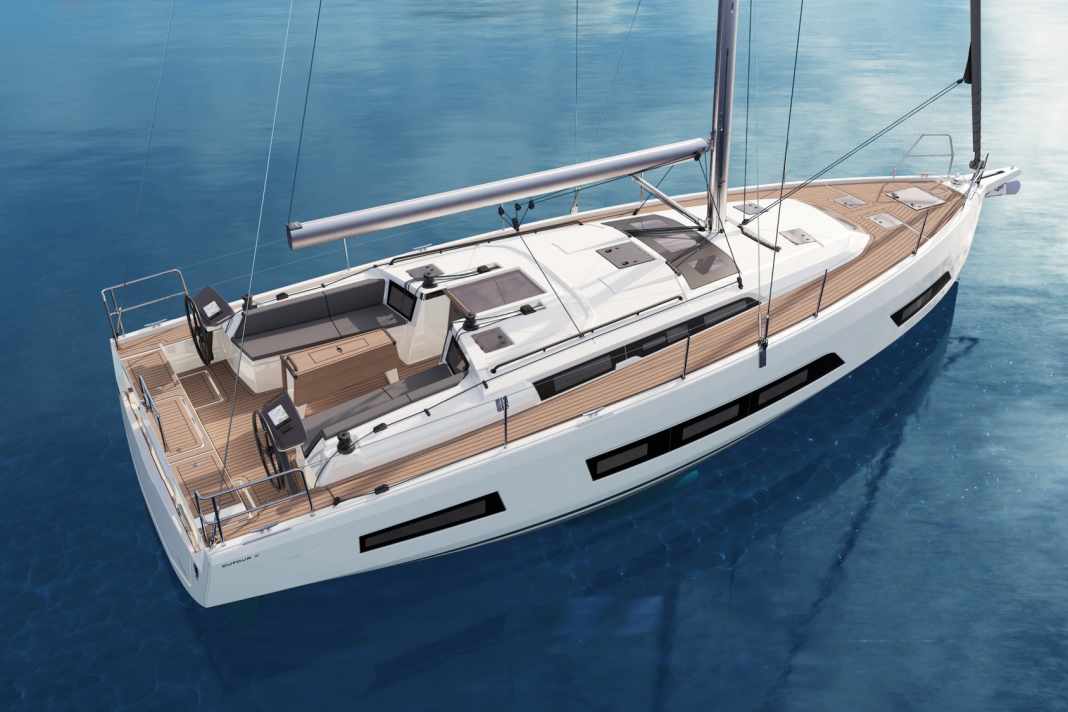





Simple, functional and clear
Nothing too little, nothing too much. The cockpits of touring yachts are specifically designed to be as easy to use as possible. The most important functions for setting and adjusting the sails are available and usually easy to reach. Safety, protection and comfort are the key factors in cockpit design. Active and sporty sailors, on the other hand, quickly reach their limits and would like more options for trimming. These are often available as optional packages from the shipyard.
- + Simple and clear handling, even during manoeuvres
- + Plenty of space in the cockpit for relaxing and sunbathing
- - Limited options for fine-tuning the sails
- - Often simple basic equipment with inferior fittings
Walkaround. Layout with exemplary character
The term is to be taken literally. It's about getting from the cockpit to the foredeck without any obstacles or climbing. Although the idea is not entirely new, it is currently coming back into fashion. The high-volume manufacturer Jeanneau has now converted its entire programme to this special layout. On the Sun Odyssey models, recessed running decks make the passageways easier.
- + Unobstructed access to the foredeck around the steering wheel
- + Efficient working positions on the winches
- + Excess water is channelled
- - Little space for the helmsman to sit on the side of the wheel
Performance cruisers: the focus is on strong performance
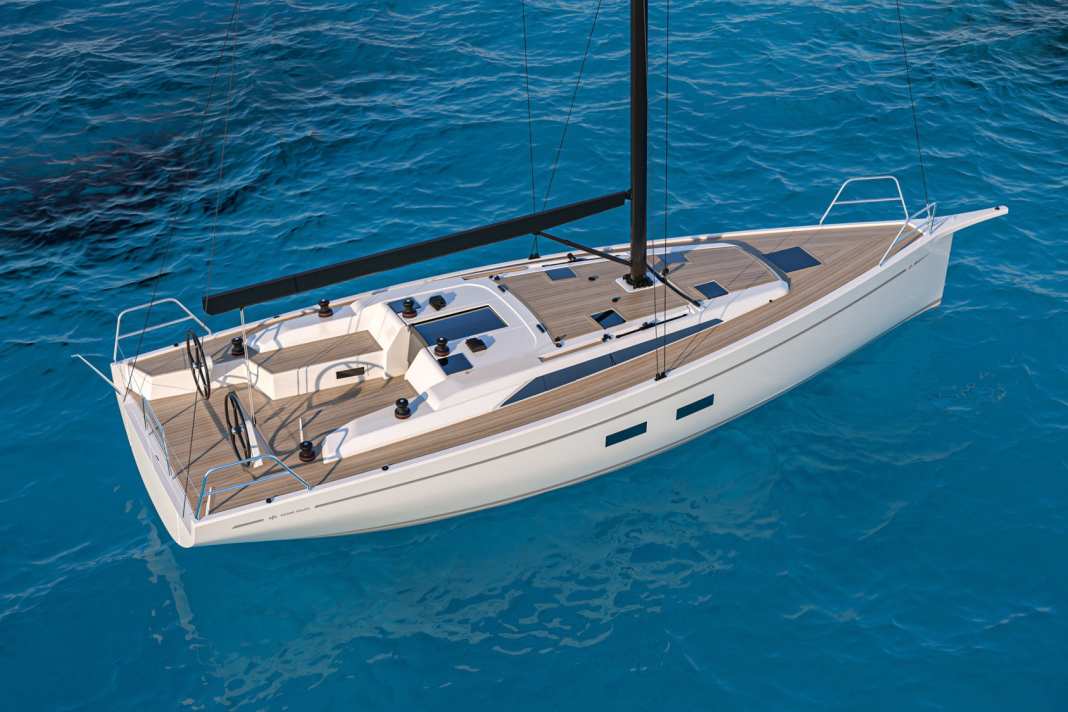





More space for active sailing
Compared to pure cruising yachts, performance cruisers have a clear shift in emphasis towards sportiness. There are numerous sheets and trim lines on board, and the technical layout is more complicated with significantly more functions. This requires space and room for the crew to move freely during manoeuvres. The cabin superstructure of performance cruisers is therefore often shorter and the cockpit more spacious than on comparably sized cruising boats. However, the thwarts usually remain short.
- + Large, open cockpit with plenty of space for a crew to work
- + Fast manoeuvring sequences thanks to many winches and lines for numerous functions
- - Short dykes and little comfort for the crew in the harbour
- - Only limited one-handed use
Sport and performance without compromise
In racing yachts, which are designed for tough, intensive regatta use, comfort falls completely by the wayside. Here, it is all about the most efficient handling possible and optimum manoeuvring sequences for a well-coordinated crew. The trim options are extremely varied, complicated and technically sophisticated. Naturally, only the highest quality material is considered for the equipment on deck. Pure racers such as a TP52 require skill and experience.
Everything to the rear. That also works
Sporty sailing characteristics yes, but preferably with a small crew. Performance cruisers meet this requirement with a consistent line routing to the rear of the helm stations, where the helmsman can also work single-handedly on the winches. However, in these cases there are a lot of sheets, halyards and trim lines, which makes handling confusing and often leads to a large tangle of lines.
- + All functions can also be accessed by the helmsman
- + No lines in the cockpit or at the companionway
- - Unclear sheet guidance, difficult handling
- - Little space for a team to work
French speciality - the RM concept
RM Yachts in France builds sporty yachts from plywood. But that is not the only special feature of the brand. The layout in the cockpit is also quite special. All halyards and trim lines as well as the mainsheet and genoa sheet run back over the cabin superstructure to a total of four winches on the companionway, which are mounted on platforms at different heights. With a small crew, this unusual arrangement also worked very well in the test. However, it is not suitable for single-handed sailing.
Centre cockpit: as high and secure as a fortress
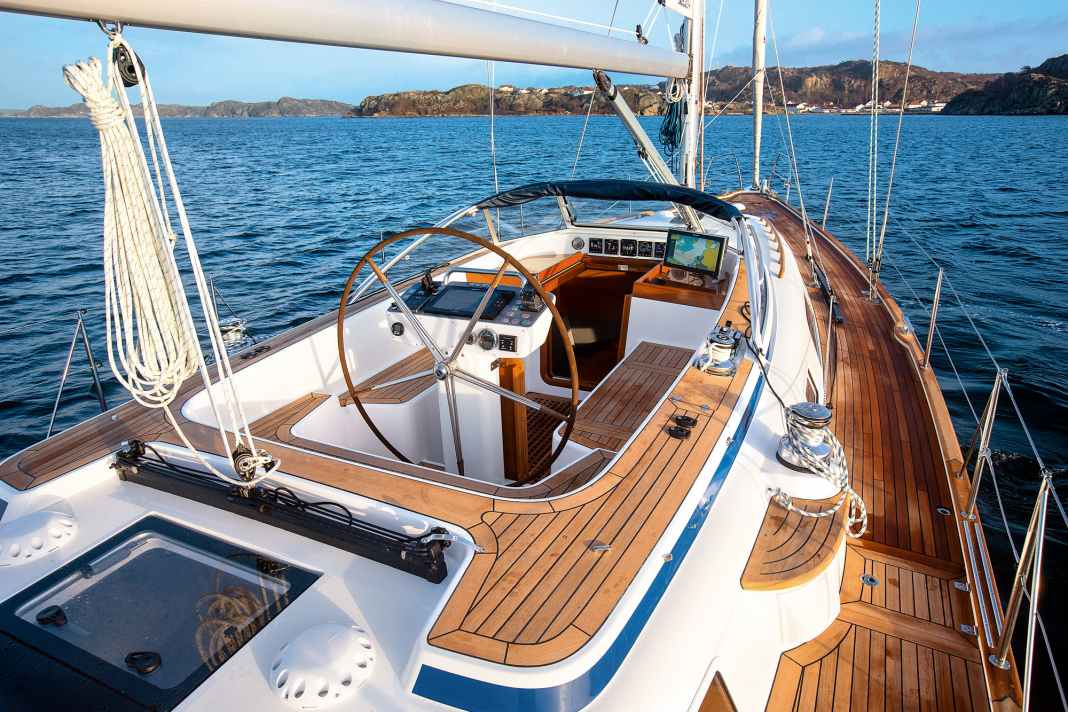


Yachts with a centre cockpit are particularly suitable for use on long, demanding voyages. As the name suggests, the cockpit is positioned more towards the centre of the ship. The reason for this is that they are fitted with a large owner's cabin aft. Due to their high, central position, centre cockpits offer good protection and maximum safety.
- + Safe, seaworthy cockpit concept
- + Very good protection, often also thanks to a fixed windscreen
- - Little freedom of movement for the crew and helmsman
- - Two steering positions are only possible on large centre cockpit yachts
Daysailer: reduced to the essentials
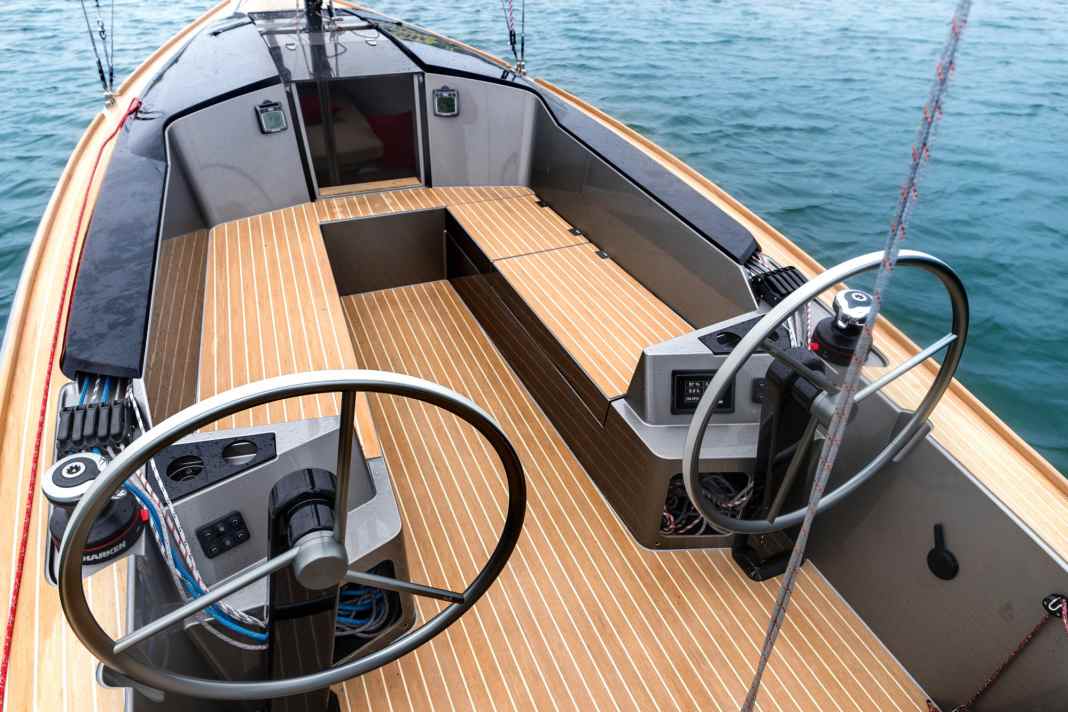


After work, just hop on the boat, hoist the sails and take a short relaxing spin. The market offers various boats and designs for daysailing. Nevertheless, there are similarities. The handling of daysailers must be as simple as possible and, above all, suitable for single-handed use, the on-board technology is reduced, but the fun factor is maximised.
- + Simple, clear handling
- + Strong focus on unrestricted one-handed suitability
- - Usually only few trimming options, low sportiness
- - Conceptually unsuitable for touring, offshore and long strokes
Trendsetter or fixed idea? The special case of Jeanneau Yachts 55

Following the successful introduction of the walkaround idea, Jeanneau has once again caused a stir in the yacht building industry with the launch of the Jeanneau Yachts 55 with a complete reinterpretation of the cockpit design. On the Jeanneau 55, the helm stations are built far forward to create two huge lounge areas on the aft deck, which can be rearranged and used as desired. The entire cockpit up to the stern can be partially or completely covered with flexible or fixed elements. And the two aft cabins can be accessed directly from the cockpit via separate companionways.
The cockpit concept of the Jeanneau Yachts 55 includes the targa bar and the fixed sprayhood with windscreen in front of the companionway. As with the test boat, the entire forward cockpit area is protected from the weather, wind and sun. The navigation system is not installed below, but on deck in the cockpit. In the shelter of the canopy, you sit in an elevated position with a good view on all sides. Whether Jeanneau's innovative cockpit concept can set a precedent remains to be seen.

